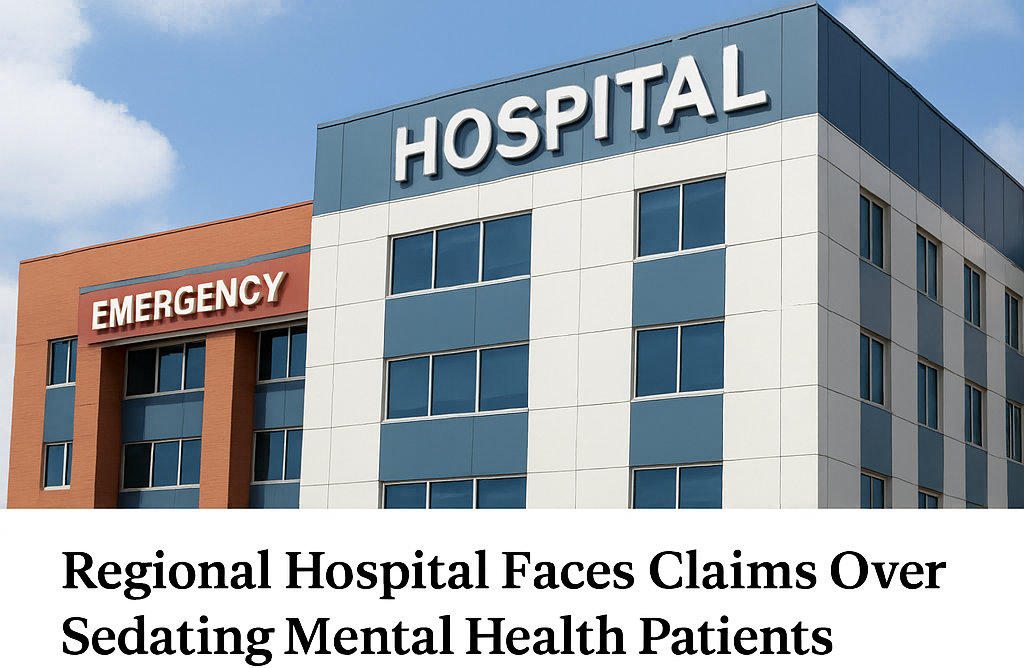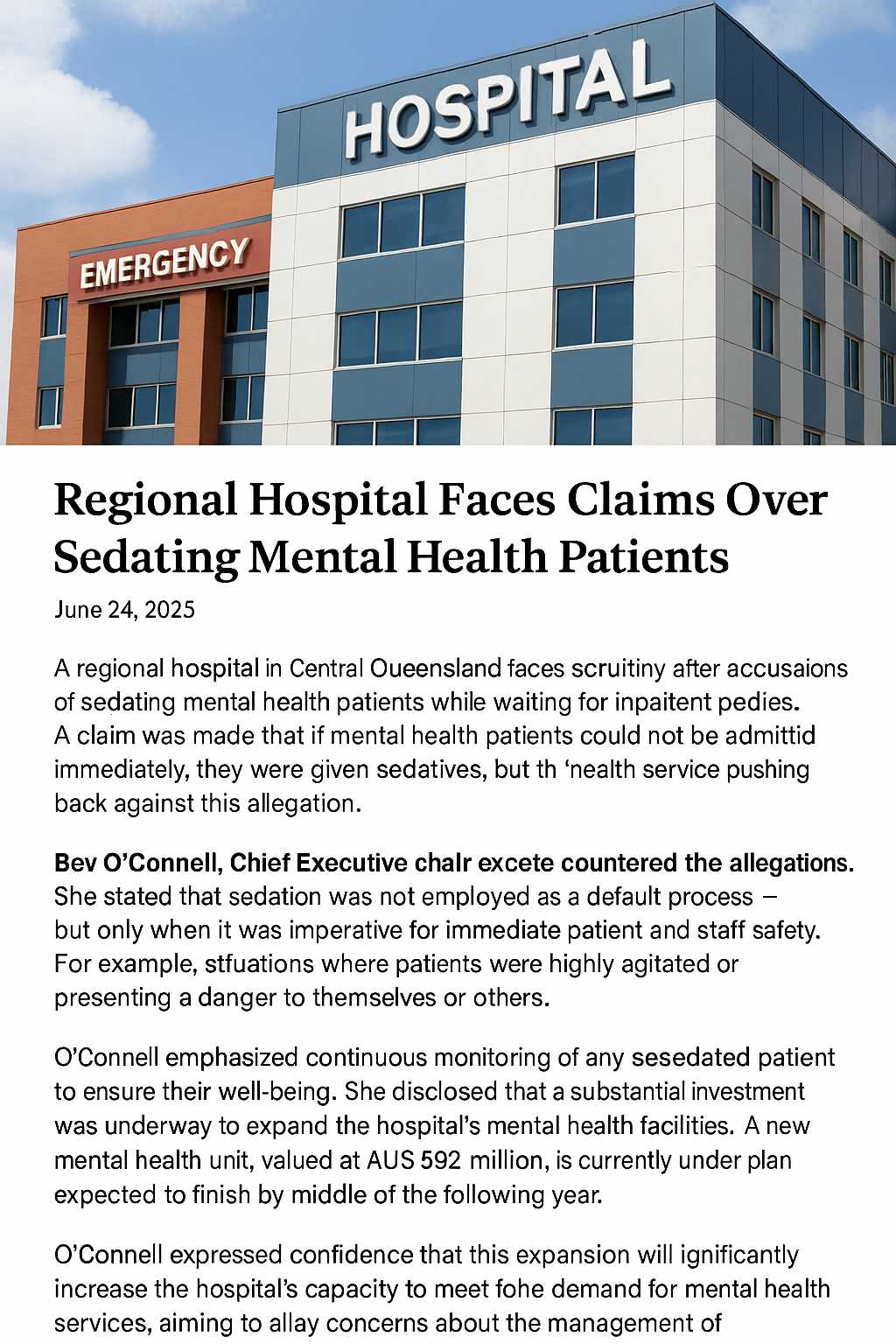
Regional Hospital Faces Claims Over Sedating Mental Health Patients: A Deep Dive into Ethics, Overcrowding, and Systemic Pressures S
In recent weeks, the healthcare community in Central Queensland and beyond has been rocked by serious allegations involving a regional hospital accused of sedating mental health patients as they waited for inpatient beds. The claims—though firmly denied by the hospital’s leadership—have opened a window into the challenges of modern psychiatric care, igniting debates about ethical practices, staff shortages, infrastructure gaps, and patient rights.
This blog post explores the situation in detail, incorporating hospital responses, community reactions, legal implications, and broader systemic failures—while highlighting the path forward for more humane, effective, and ethical mental health care in Australia.
1. The Allegations: Sedation in the Emergency Department in Hospital
Reports first emerged from patients’ families and some former staff members who claimed that mental health patients—often in severe distress—were being sedated as a routine measure while waiting for psychiatric admission. The issue came to light amidst increasing pressure on emergency departments (EDs), where long wait times for mental health beds have become the norm rather than the exception.
In these allegations, sedation wasn’t reserved for medical emergencies, but was allegedly used to “keep patients calm” during extended ED stays. Critics argue that such a practice, if proven, not only undermines patient dignity but also potentially breaches clinical ethics and legal frameworks.
One anonymous staff member said:
“You have patients in crisis—sometimes suicidal, sometimes terrified—and you’re left with no beds, no space, and no options. Sedation becomes the default, not because we want to, but because we’re overwhelmed.”
2. Hospital’s Firm Response: “Safety-First, Not Routine”
The hospital’s CEO, Bev O’Connell, swiftly addressed the accusations in a press conference. She firmly denied the notion that sedation was used indiscriminately and clarified the hospital’s position:
“We are committed to delivering the highest standard of mental health care. Sedation is not a routine measure. It is used only when a patient’s behavior poses an imminent risk to themselves or others, and always under the strictest clinical supervision.”
According to O’Connell, protocols are in place to ensure any such intervention is justified, monitored, and followed by appropriate care. She further pointed out that staff receive extensive training in non-pharmacological de-escalation techniques, emphasizing a “safety-first, dignity-always” approach.
Despite her assurances, the lack of transparency around sedation records and the emotional testimonies from families have continued to fuel skepticism.
3. A System Under Pressure: Mental Health Infrastructure Gaps
While the hospital’s response underscores a commitment to best practices, the broader issue remains: the mental health care system is stretched to its limits.
In Australia, and particularly in regional areas, demand for mental health services has surged in recent years due to:
- The long-term impacts of the COVID-19 pandemic
- Rising cost-of-living stress
- Youth mental health crises
- A growing awareness of psychiatric disorders
Emergency departments have become a “catch-all” for acute mental health needs, even though they were never designed for prolonged psychiatric care. This strain has left clinicians scrambling for solutions in a system that often gives them too few.
4. The $92 Million Expansion Plan: Hope for the Future
In an effort to address these critical gaps, the hospital has announced a bold AUS $92 million expansion of its mental health facilities. The project includes:
- A new state-of-the-art mental health unit
- Expanded inpatient bed capacity
- Dedicated observation units for psychiatric patients in crisis
- Facilities for crisis stabilization and therapeutic support
- Additional staff hires, including psychologists, social workers, and peer-support specialists
Bev O’Connell described the expansion as “transformational,” predicting it will “reshape the way we deliver mental health care in this region.”
Construction is already underway and expected to be completed by mid-2026. While the initiative is welcome, critics argue that relief is urgently needed now, not in two years. In the meantime, hospitals are left to manage the fallout with limited resources.
5. Sedation and the Law: What Are the Rules?
Australian mental health law provides strict guidelines on when and how sedation can be used. Sedation is permitted in emergencies to prevent imminent harm—but must be:
- Clinically justified and proportionate
- Administered with the patient’s consent whenever possible
- Reviewed and recorded in patient medical charts
- Supervised continuously
Failure to meet these conditions could be deemed unlawful or even abusive.
Legal and human rights organizations are calling for a formal independent investigation, not only into this hospital’s practices but also into sedation usage rates across Queensland.
6. Family Voices: Fear, Confusion, and Advocacy
Perhaps the most compelling element in this unfolding situation is the emotional toll on families. Several parents and siblings have come forward with troubling stories.
One mother recounted how her 19-year-old daughter, suffering from a manic episode, was sedated twice in the emergency room:
“No one explained anything. I didn’t know what they gave her. She slept for hours, and when she woke up, she was terrified. She thought she was being punished.”
Stories like this raise profound concerns about informed consent, communication, and trauma-informed care. For families already struggling with the emotional weight of a loved one’s mental illness, such experiences deepen mistrust in the healthcare system.
7. Staff Burnout and Moral Injury
Behind every accusation and policy, there are overworked and under-supported healthcare workers. Nurses, social workers, and doctors dealing with mental health emergencies often face:
- High patient volumes
- Insufficient psychiatric beds
- Lack of access to rapid mental health assessments
- Fear of litigation or regulatory action
This pressure can lead to what’s known as “moral injury”—the psychological distress that arises when one is forced to act in ways that go against personal or professional ethics.
“We don’t come to work to sedate patients,” said one ED nurse. “But when it’s midnight, the psych team’s off-duty, and a patient is screaming or harming themselves, what do you do?”
Better support, training, and crisis resources are critical to protecting both patients and the people who care for them.
8. Community Reactions: Protest and Mobilization
The allegations have sparked outrage among mental health advocacy groups. In Brisbane and nearby towns, community forums and rallies have been organized, demanding:
- Transparency on sedation practices
- Immediate government oversight
- Greater funding for crisis services
- Legal accountability where necessary
Advocates argue that real change will only come when mental health is treated with the same urgency and investment as physical health.
9. What Needs to Change: Policy Recommendations
Experts and advocacy groups are now urging governments at all levels to take a comprehensive approach. Key recommendations include:
- Establish independent review panels to audit sedation and restraint usage
- Mandate real-time reporting of patient treatment in emergency mental health cases
- Expand community-based mental health clinics to reduce ED overflow
- Recruit and train more crisis intervention teams, including mental health first responders
- Educate the public and patients on their rights through easy-to-understand resources
These reforms can help shift the culture of care from reaction to prevention, from sedation to support.
10. A National Reflection on Mental Health Care
This situation isn’t just about one hospital—it’s about a national system under immense strain. For decades, mental health has been underfunded, stigmatized, and politically sidelined.
Yet in 2025, more Australians than ever are seeking help for depression, anxiety, trauma, and complex psychiatric disorders. If the infrastructure doesn’t meet this need, cases like this will continue to surface—along with the human suffering that accompanies them.
Conclusion: Beyond Sedation—Toward a Culture of Compassion
The allegations of improper sedation in Central Queensland’s regional hospital have become more than just a local scandal—they’ve become a lens through which we view the entire ecosystem of mental health care in Australia.
Whether or not these claims are ultimately validated through investigation, the message is clear: Mental health patients deserve better. They deserve to be treated with dignity, compassion, and agency—even—and especially—in moments of crisis.
As Australia invests in infrastructure and legislation, it must also invest in culture, empathy, and systemic accountability.
The future of mental health care depends not just on buildings and budgets, but on our collective commitment to healing, humanity, and hope.
Would you like this turned into a designed blog page, PDF, or printable brochure? I can also include quotes, graphics, and infographics tailored to your brand or organization.




